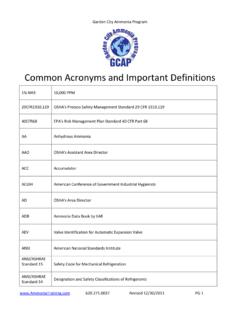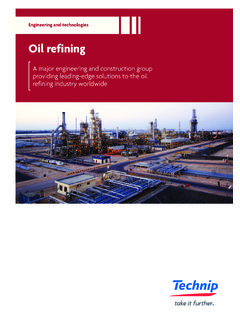Transcription of TÜV Rheinland Functional Safety Engineer Certificate ...
1 T V Rheinland Functional Safety Engineer Certificate (Process Hazard & Risk Analysis) This 3 day course covers the fundamentals of PSM, hazard identification and risk analysis, evaluation and treatment, as well as focussing on the principal methods including HAZID, HAZOP, LOPA, FMEA, QRA, and the increasingly popular bowtie analysis. It demonstrates how to apply theory in practice, using simple and more complex examples to illustrate key points. The course is considered essential for anyone who is involved in PH&RA. Risktec Solutions, part of the T V Rheinland Group, is a leading authority on providing advice and technical support to clients operating in the major accident hazard sectors, including oil and gas, chemicals and nuclear sectors. Risktec s consultants have unparalleled technical knowledge and practical experience in identifying and providing process Safety and risk management solutions in all the major hazard industries.
2 At the end of the course you will be able to: 1. Apply the most popular and internationally adopted methods and tools for identifying and managing the risks associated with process-related hazards. 2. Actively participate in and give effective support during the whole process hazard and risk analysis approach. 3. Identify hazards and analyze risk, including applying the IEC 61882 HAZOP standard. 4. Relate the requirements of Functional Safety according to IEC 61508 / IEC 61511 to process hazards and risk analysis. Who should attend? Process engineers, Safety engineers and managers, instrument engineers and operations personnel, plant and operations managers. Anyone accountable for the assessment and management of risks and hazards in the process industries. Persons involved in management, engineering, operations and Safety of process operations. Persons with HAZOP study experience and a basic knowledge of loss prevention and safe working practice.
3 This training will not be industry-specific, so we invite attendees from all major hazard industries, such as oil and gas, petrochemical, chemical, nuclear, transportation and mining. Location and Date Where: Singapore (exact location TBA) When: Tuesday 31st May to Friday 3rd June 2016, 9am to 5pm (half day on Friday 3rd) Controlling risks within major hazard enterprises requires a robust process Safety management (PSM) system and the experienced application of process hazard and risk analysis (PH&RA) techniques. This PH&RA course is part of the T V Rheinland Functional Safety Program. Participants who successfully pass the examination will receive a T V Rheinland Functional Safety Engineer (Process Hazard and Risk Analysis) Certificate . Programme The purpose of the training course is to introduce the Process Hazard and Risk Analysis techniques routinely encountered in the identification and assessment of major accident hazards.
4 The course covers the common risk assessment and treatment techniques deployed in process Safety (technical Safety ) risk management. Each technique is reviewed and illustrated using relevant examples and exercises to reinforce the key principles. The course comprises slides, several videos and, most importantly, 25 activities designed to enhance the knowledge and practical skills of participants. It provides a hands-on learning experience, with the emphasis on the activities. Many of the slides provide backup content for reference purposes. All of the topics are covered during the course but the trainers flex the time spent according to the experience and wishes of the participants. The course concludes on the morning of Day 4 with a 3 hour examination paper which comprises multiple choice questions and longer case study style questions. It is a closed book, closed notes exam. Use of calculators is allowed and one will be provided if required.
5 Successful completion of the exam, by attaining a pass score of 75% or higher, registers the candidate as a T V Rheinland Functional Safety Engineer (Process Hazard and Risk Analysis), subject to satisfying the eligibility requirements. The Risktec trainer is a T V Rheinland FS (PH&RA) Expert and is an active practitioner in the process sectors. He has extensive training experience and utilizes accelerated learning techniques. All Risktec trainers draw heavily on their practical experience when delivering this training course and provide examples of the use of process hazard and risk analysis techniques as applied in the real world. The following topics are covered over the first 3 days: Introduction TR Functional Safety Program Process Safety Management Process Safety accidents Risk management process Risk identification What if? HAZID study HAZOP study FMEA Risk analysis Risk matrix Bowtie analysis Fault & Event Tree Analysis Physical Effects Modelling Risk analysis Quantitative Risk assessment Layer of Protection Analysis SIL assessment Human factors in design Risk evaluation Legislative regimes Risk criteria ALARP assessment Cost-benefit analysis Risk treatment Risk control hierarchy Inherently safer design Process Safety during facility lifecycle Risk managing Communication Consultation Monitoring Review Putting it all together Selecting the right technique Planning PH&RA studies Facilitating workshop studies Reporting PH&RA studies The 3 hour examination is held on the morning of the fourth day.
6 You must answer all of the multiple choice questions but you may select which of the longer questions to answer from a larger set of questions. The pass score is 75%. PH&RA, Issue , Slide 42 2015 Risktec Solutions Limited Process Safety Management System (PSMS): 4 main focus commitment and and compliance with legislation and industry selection, placement and competency, health with identification and risk , records and knowledge manuals / / operational status monitoring and of operational and of readiness and process and of Safety critical to work, work control, task and supplier selection and reporting and , assurance, management review and intervention PSM FrameworkEnergy InstitutePH&RA, Issue , Slide 79 2015 Risktec Solutions Limited HAZOP processSelect nodeIdentify consequences of deviation and rank severityRecord all consequencesIdentify safeguards and rank event likelihoodReport:Management summaryTeam membersHAZOP Record SheetsHAZOP Action SheetsMarked-up P&IDsSelect deviation (parameter and guideword pair)Identify possible causesIdentify any recommend-ationsRecord all safeguardsRank all actions and assign to relevant personRepeat for all nodesRecord all causesPH&RA, Issue , Slide 112 2015 Risktec Solutions Limited Choice of approachRisk LevelComplexityQualitativeSemi-Quantitat iveQuantitativeLow complexitySolution is obviousSituation covered by codes and standardsHigh complexityDifficult solutionOne-off situationNo relevant standards/guidanceBroadlyAcceptableALARP R egionIntolerableAfter.
7 Guidance on Risk assessment for Offshore Industries HSE 3/2006 Bowtie analysisRisk matrixLOPASILFTAETAPEMQRAPH&RA, Issue 1, Slide 112 2015 Risktec Solutions Limited COMMUNITY EMERGENCY RESPONSEE mergency broadcastingPLANT EMERGENCY RESPONSEE vacuation proceduresMITIGATIONM echanical mitigation systems Safety instrumented control systemsSafety instrumented mitigation systemsOperator supervisionPREVENTIONM echanical protection systems Process alarms with operator corrective actionSafetyinstrumented control systemsSafety instrumented prevention systemsCONTROL and MONITORINGB asic process control systemsMonitoring systems (process alarms)Operator supervisionPROCESST ypical layers of protection (risk reduction) found in process plantsThe LOPA onion LOPA follows the hierarchy of effectiveness of control measuresPH&RA, Issue 1, Slide 35 2015 Risktec Solutions Limited Individual risk criteriaUnacceptableregionBroadly acceptable regionTolerable if ALARP regionRisk is taken only if a benefit is requiredRisk cannot be justified except in extraordinary circumstancesTolerable only if risk reduction is impracticable or if its cost is grossly disproportionate to the improvement gainedTolerable if cost of reduction would exceed the improvementWorkers Public10-3 IRPA 10-4 IRPAW orkers Public10-6 IRPA 10-6 IRPAT hese criteria are generally accepted internationally as applicable for hazardous industriesRisk generally insignificant.
8 Risk reduction usually not required (unless reasonably practicable)PH&RA, Issue 1, Slide 63 2015 Risktec Solutions Limited Risk treatment (recap)AvoidReduceAcceptTransferThe activity is just too risky Stop an existing activity Avoid a new activityThe risk can be reduced cost-effectively Inherently safer design Implement preventive controls Implement mitigation/ recovery controlsTransfer legal responsibility or financial impact By contract By insurance But many risks are uninsurable, and most of cost of loss is still borne by operator Does not protect market share or reputationAccept the residual risk, it is tolerable But ensure continuous improvement of risk controlIDENTIFYANALYSEEVALUATERisk assessmentRisk treatmentAlso called 4Ts: Terminate, Treat, Tolerate, TransferPH&RA, Issue 1, Slide 89 2015 Risktec Solutions Limited and consultation, monitoring and reviewConsequence AnalysisFrequency AnalysisRisk AnalysisCommunication andConsultationMonitoring and ReviewEstablishing the ContextRisk IdentificationRisk AnalysisRisk EvaluationRisk TreatmentRisk AssessmentPH&RA, Issue 1, Slide 108 2015 Risktec Solutions Limited Drivers for risk assessment through facility lifecycle (asking the right questions)What hazards can be optioned out?
9 How can the remaining hazards be managed?Are our operating and maintenance hazards still being controlled?Are there any new or changing hazards?What liabilities remain?What is the obligation to return to original condition?What workplace hazards need to be controlled?What hazards are present?What hazards can be designed out?How can the remaining hazards be managed?What construction workplace hazards are there?Design, build, modifyOperate and maintainLife extension, decommissionConcept evaluationScreening/ acquiring assetHazards must be identified and risks assessed at each stage of a facility s life, from design & build, commissioning, operations & maintenance, to decommissioning, etc. Course Leader Andy Lidstone CPhys, MInstP, FS Expert (T V Rheinland , PH&RA) Andy has over 20 years experience in the field of Safety and risk assessment and has worked in a number of industries, including oil and gas, mining, nuclear and defence, transport, manufacturing and chemical sectors.
10 Over the past 15 years, Andy s work has been predominately in the oil and gas industries, managing projects for facilities including refineries, mines, gas plants, drilling rigs and logistics operations. His expertise includes techniques such as bowties, fault and event tree analysis, failure modes and effects analysis, consequence modelling, QRA, hazard identification, preparation and roll-out of HSE cases and qualitative and quantitative risk assessments. Andy frequently provides training in these topics together with incident investigation training. Andy is a T V Rheinland Functional Safety Expert (PH&RA), and a lead teacher on Risktec s Postgraduate Education programmes in Risk & Safety Management. Eligibility Requirements The following requirements must be met for candidates to attain the FS Engineer (T V Rheinland ) Certificate : a minimum of 3 years experience in the field of Functional Safety , and University degree (Master's or Bachelor's degree in Engineering) or equivalent Engineer level responsibilities status as certified by employer, and attendance at the course, and successful completion of the examination.





